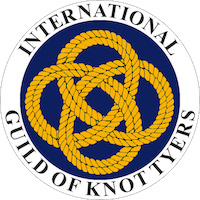A Comprehensive Text of Turk’s Head Knots by James Edward Harvey
Nova Creative Publishing, 1997 ISBN 9780958702621
This is indeed a comprehensive text but certainly not one for the beginner. This is a book by a dedicated expert with an intimate understanding of his subject, who justifiably took great pride in his work, writing about what he knows for an audience which he assumes knows what he is writing about.
The author acknowledges he was taught the art of raising a knot by formula. called ‘The Rule’ by his maritime peers and states that “All knots after completion can be raised or increased to a larger knot by using formula A or B.” ‘The Rule’ (or ‘by formula’) and ‘formula A or B’ are subsequently referenced throughout the text in support of the numerous explanations and excellent diagrams but frustratingly, I could find no definition of these concepts.
After some analysis, a bit of research and some expert suggestion (thanks Ed), I believe formulas A and B simply refer to be the method of raising a knot (increasing the number of Parts and Bights) by what I understand as ‘laying and then splitting tracks’. Formula A being the approach where the working end is taken back through the knot on the ‘inside’, where a new bight is created immediately before the standing end, and formula B where it is taken back through the knot on the ‘outside’ where a new bight is created immediately after the standing end. The inference in the text is that ‘The Rule’ was learnt as a mnemonic. I’m rather hoping some ‘Old Salts’ out there might remember such an aide memoire. If so, I’d love to hear it.
I suggest the key to approaching this book is provided by the author’s warning on the second page: “Some people spend hours working out crosswords, others like to solve chess problems or Chinese puzzles. This is a book for those who like a challenge.” It certainly is that and, like all good puzzle books, contains lots of cryptic clues, mysterious codes and head-scratching to find the answers but there are hidden gems that make the effort worthwhile. Even the most accomplished knot tyer would have to be impressed to read that James Harvey considered the 20 x 11 Turks Head Base Knot “... about the largest base knot that can be formed on the hand”. I find that wonderful. Now there’s a challenge! The illustrations of completed projects alone are a superb reference of examples of what is possible even if it is not entirely clear how it is possible and, for that reason alone, I suggest this book deserves a place in any enthusiast’s library.
Jim Caswell

